Mica (Wet Ground)
Our muscovite mica is a wet ground mineral mined and processed in Kings Mountain, North Carolina. Muscovite mica is used for applications requiring reinforcement and where greater resistance to moisture, heat, light or chemicals is needed. As a platy mineral, muscovite mica offers beneficial rheological properties and is chemically inert. Muscovite mica is also used to brighten the tone of colored pigments offering interesting decorative effects, such as pearlescence. These properties render muscovite micas as excellent functional minerals for paint and many other applications.
Our muscovite mica has a high aspect ratio and can be used in a wide range of applications, including:
Paint: Provides improved barrier properties against moisture and vapor, promotes adhesion, reduces cracking and checking.
Foundry Coatings: Controls permeability, improves surface quality, and is heat resistant.
Adhesives and Sealants: Controls shrinkage and reduces cracking.
Plastic Composites: Substantially increases stiffness and heat resistance, while promoting dimensional stability and improving electrical insulation properties.
Origin and History
Mica is a group of sheet silicate (phyllosilicate) minerals that includes several closely related materials having highly perfect basal cleavage. All are monoclinic with a tendency towards pseudo-hexagonal crystals and are similar in chemical composition. The highly perfect cleavage, which is the most prominent characteristic of mica, is explained by the hexagonal sheet-like arrangement of its atoms.
Common micas include biotite, lepidolite, muscovite, phlogopite and zinnwaldite. Muscovite mica is a phyllosilicate mineral of aluminum and potassium with the formula KAl2(AlSi3O10)(F,OH)2, or (KF)2(Al2O3)3(SiO2)6(H2O). It has a highly-perfect basal cleavage yielding remarkably-thin laminae (sheets) which are often highly elastic.
Muscovite has a Mohs hardness of 2.0 to 2.5 parallel to the face, 4.0 perpendicular to the face and a specific gravity of 2.76 to 3.00. It can be colorless or tinted through grays, browns, greens, yellows, or (rarely) violet or red, and can be transparent or translucent. It is anisotropic and has high birefringence. Its crystal system is monoclinic. The green, chromium-rich variety is called fuchsite; mariposite is also a chromium-rich type of muscovite.
Muscovite is the most common mica, found in granites, pegmatites, gneisses, and schists, and as a contact metamorphic rock or as a secondary mineral resulting from the alteration of topaz, feldspar, kyanite, etc. In pegmatites, it is often found in immense sheets that are commercially valuable.
The word "mica" is derived from the Latin word mica, meaning "a crumb", and probably influenced by micare, "to glitter". The name "muscovite" comes from Muscovy-glass, a name formerly used for the mineral because of its use in Russia for windows.
Source
Mica is produced in many countries around the world. In the United States, North Carolina is the major producer, accounting for more than half of the total domestic output. The remainder is produced in nine other states. Mica mining in the United States is confined largely to pegmatites and schists. Most mica is obtained by crushing and milling pegmatites and to a lesser extent as a byproduct of feldspar and spodumene mining.
Mica is one of the most difficult minerals to grind. Some of the same properties that make mica useful make it difficult to grind. Even thin flakes are tough and elastic and resist abrasion and reduction in size by conventional types of grinding equipment.
Two processes, dry grinding and wet grinding, are employed to produce ground mica. The products of the two processes differ from each other in certain physical properties. Wet-ground mica, which retains the brilliancy of its cleavage faces, is used primarily in pearlescent paints. Many metallic looking pigments are composed of a substrate of mica coated with another mineral, usually titanium dioxide. The resultant pigment produces a reflective color depending on the thickness of the coating.
Wet-ground mica is produced in chaser mills. The grinding surfaces of the mills usually are made of wood to preserve the luster or sheen of the mica. The type of mill usually employed consists of a steel tank lined with wooden blocks laid with the end grain up. The rollers used are also made of wood and revolve at 15 to 30 rpm. The mica is fed from hoppers to the mill where water is gradually added to form a thick paste. Each batch is ground 6 to 8 hours depending upon the feed material and the fineness desired. After grinding, the mica is discharged to sediment traps where the coarse mica is recycled for further grinding. The fine-size mica is then screened on a trommel (a rotating cylindrical sieve or screen used for washing and sorting minerals) to remove undesirable foreign matter. The mica slurry is then thickened, filtered and dried. The dried product is then screened and bagged for shipment.
Toxicity
Mica is not considered to be a hazardous material, but care must be exercised when using the powder to avoid inhaling it, which can irritate the lungs and aggravate a pre-existing respiratory condition.
| Properties | |
| Description | Fine wet-ground muscovite mica |
| Source | Kings Mountain, North Carolina |
| Chemical Name | Phyllosilicate mineral of aluminum and potassium |
| Chemical Formula | KAl2(AlSi3O10)(F,OH)2 |
| CAS No. | 1200-1-26-2 |
| Typical Physical Properties | |
| Loss on Ignition (@ 1000° C) | 4.2% |
| Moisture (@ 100° C) | 0.5% |
| Oil Absorption | 32 g oil / 100 g pigment |
| Mohs Hardness | 2.5 |
| Bulk Density | 11 lbs./ft3 |
| Specific Gravity | 2.82 |
| pH | 6.9 |
| Refractive Index, mean | 1.58 |
| Dielectric Constant | 7.5 |
| Median Particle Size | 34 microns |
| Aspect Ratio (Jennings) | 85 |
| SKU | 510-15MWG |
|---|---|
| Brand | Rublev Colours |
| Vendor | Natural Pigments |
| Processing Time | Usually ships the next business day. |



